Costorage and corelease of modulatory peptide cotransmitters with partially antagonistic actions on the accessory radula closer muscle of Aplysia californica
- PMID: 8987834
- PMCID: PMC6579219
- DOI: 10.1523/JNEUROSCI.16-24-08092.1996
Costorage and corelease of modulatory peptide cotransmitters with partially antagonistic actions on the accessory radula closer muscle of Aplysia californica
Abstract
Many neurons that contain a classical neurotransmitter also contain modulatory peptides, but it has been difficult to establish unequivocally that these peptides are functional cotransmitters. Here, we provide evidence for functional cotransmission in a neuromuscular system of Aplysia. Using immunocytochemical techniques, we localize members of two peptide families, the small cardioactive peptides (SCPs) and the buccalins (BUCs), to a single subset of dense-core vesicles in the terminals of the cholinergic motorneuron B15. We describe a new preparation and method for the direct detection of released peptides and show that the SCPs and BUCs are released when neuron B15 is intracellularly stimulated. Consistent with their subcellular localization, the SCPs and BUCs are released in a stoichiometric ratio that is constant across conditions that change the absolute amount of peptides released. Peptide release is calcium-dependent but does not require muscle contractions. Thus, the release cannot be attributed to a displacement of peptides that may be present in the extracellular space. In previous studies, we characterized the physiological firing patterns of neuron B15. Here, we simulate these firing patterns and show that peptide release occurs. Additionally, we find that significant quantities of material are released under behaviorally relevant conditions. We find that concentrations of released peptides in the muscle are in the concentration range in which exogenously applied peptides exert characterized modulatory actions on muscle contractions. Together, our findings provide strong support for the hypothesis that peptides contained in neuron B15 are functional cotransmitters.
Figures
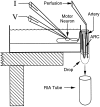



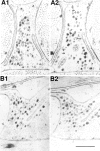



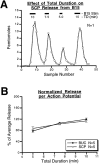
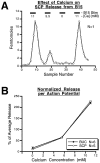
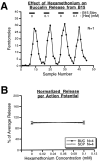
Similar articles
-
Peptide cotransmitter release from motorneuron B16 in aplysia californica: costorage, corelease, and functional implications.J Neurosci. 2000 Mar 1;20(5):2036-42. doi: 10.1523/JNEUROSCI.20-05-02036.2000. J Neurosci. 2000. PMID: 10684904 Free PMC article.
-
Release of peptide cotransmitters in Aplysia: regulation and functional implications.J Neurosci. 1996 Dec 15;16(24):8105-14. doi: 10.1523/JNEUROSCI.16-24-08105.1996. J Neurosci. 1996. PMID: 8987835 Free PMC article.
-
Release of peptide cotransmitters from a cholinergic motor neuron under physiological conditions.Proc Natl Acad Sci U S A. 1990 Feb;87(3):933-7. doi: 10.1073/pnas.87.3.933. Proc Natl Acad Sci U S A. 1990. PMID: 2153979 Free PMC article.
-
Functional roles of peptide cotransmitters at neuromuscular synapses in Aplysia.Mol Neurobiol. 1993 Fall-Winter;7(3-4):335-47. doi: 10.1007/BF02769181. Mol Neurobiol. 1993. PMID: 8179842 Review.
-
Physiology and biochemistry of peptidergic cotransmission in Aplysia.J Physiol Paris. 1993;87(3):141-51. doi: 10.1016/0928-4257(93)90025-o. J Physiol Paris. 1993. PMID: 7907908 Review.
Cited by
-
Release of a single neurotransmitter from an identified interneuron coherently affects motor output on multiple time scales.J Neurophysiol. 2013 May;109(9):2327-34. doi: 10.1152/jn.01079.2012. Epub 2013 Feb 13. J Neurophysiol. 2013. PMID: 23407357 Free PMC article.
-
Identification of a new neuropeptide precursor reveals a novel source of extrinsic modulation in the feeding system of Aplysia.J Neurosci. 2005 Oct 19;25(42):9637-48. doi: 10.1523/JNEUROSCI.2932-05.2005. J Neurosci. 2005. PMID: 16237168 Free PMC article.
-
Optical measurements of presynaptic release in mutant zebrafish lacking postsynaptic receptors.J Neurosci. 2003 Nov 19;23(33):10467-74. doi: 10.1523/JNEUROSCI.23-33-10467.2003. J Neurosci. 2003. PMID: 14627630 Free PMC article.
-
A pair of reciprocally inhibitory histaminergic sensory neurons are activated within the same phase of ingestive motor programs in Aplysia.J Neurosci. 1999 Jan 15;19(2):845-58. doi: 10.1523/JNEUROSCI.19-02-00845.1999. J Neurosci. 1999. PMID: 9880604 Free PMC article.
-
Neuropeptide signaling near and far: how localized and timed is the action of neuropeptides in brain circuits?Invert Neurosci. 2009 Nov;9(2):57-75. doi: 10.1007/s10158-009-0090-1. Epub 2009 Sep 16. Invert Neurosci. 2009. PMID: 19756790 Review.
References
-
- Adams ME, O’Shea M. Peptide cotransmitter at a neuromuscular junction. Science. 1983;221:286–289. - PubMed
-
- Brezina V, Bank B, Cropper EC, Rosen S, Vilim FS, Kupfermann I, Weiss KR. Nine members of the myomodulin family of peptide cotransmitters at the B16-ARC neuromuscular junction of Aplysia. J Neurophysiol. 1995;74:54–72. - PubMed
-
- Cohen JL, Weiss KR, Kupfermann I. Motor control of buccal muscles in Aplysia. J Neurophysiol. 1978;41:157–180. - PubMed
Publication types
MeSH terms
Substances
Grants and funding
LinkOut - more resources
Full Text Sources
